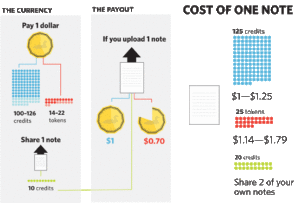Mike Sholars
Features Editor
For many university students, the situation is familiar: you miss a class, so you ask your professor for a copy of last lecture’s notes. With the odd exception, the response is usually the same: “Ask a friend.” For a variety of reasons – you’re new to the school, you have no friends in the class, or your peers have unreliable notes – this isn’t always an option.

This common dilemma inspired a trio of websites that appeared last fall, each of them with a very similar solution.
The odds of three websites – in the same region – offering very similar services and launching within a month-and-a-half of each other are improbable to say the least. The fact two of them offer the same key service (note-buying and -selling), were beta-tested in the Kitchener-Waterloo area and went online within two weeks of each other is downright uncanny.
Their services have never before been offered to Ontario students, and like many new ventures, they’re flanked by questions. StudyMonkey and NoteWagon allow students to exchange money for credits used to purchase course notes. Students upload all content, and both sites pay the uploading members a commission every time their notes are downloaded.
The third website, Notesolution, is the a little different: while it doesn’t charge money to the students downloading notes, they aren’t exactly free, either. Instead, users earn credits by performing social actions on the site, such as inviting friends to the service and uploading their own course notes.
Combined, all three websites have just under 10,000 registered users between them.
If this is indeed the story of a race between rivals, it makes sense to start with Notesolution, the first website to launch of the three, and, as of January 2011, the one with the most registered users.
The original solution
As a Vancouver native who found himself transplanted to the University of Toronto to study finance and economics, Kevin Wu found the inspiration for Notesolution in his experience as an outsider.
“When I first came to Toronto, I didn’t know anyone,” recalls Wu. “When you don’t really know that many people, sometimes it might be tough to go up to someone and ask to borrow their notes.” He saw Notesolution as a tool for first-years and students coming from abroad – people who wouldn’t have the same built-in social links available to local students.
The site was first conceived in December 2009, and the details sorted out over the following six months. The site officially went online Sept. 6, 2010, though it was open exclusively to students at the University of Toronto (U of T) St. George campus. By November, however, it had expanded to the Mississauga and Scarborough U of T campuses. The site has been slow to expand to other schools, but this is part of Wu’s strategy.
“When we’re expanding, we would like to have some content [at the new school] already, because all of these note sites are really user content-driven sites. If you don’t have any content, people wouldn’t want to come back after their first visit.”
The Notesolution team thus prefers to have a collection of course notes from a university before officially launching there; Wu confirmed the site will expand to include York University beginning Jan. 31.
Notesolution’s registration process is relatively simple: you sign up with your student email, answer the confirmation letter, and then 100 “credits” are automatically dumped into your account.
Notesolution charges 20 credits for a single lecture’s notes, and 50 credits for a test or exam study guide. Once you exhaust your starter pot, you have to earn
credits – things like inviting friends to join the site, reviewing uploaded notes, and having your own notes downloaded by others net you rewards in amounts ranging from five to 30 credits.
This community-driven approach to currency is a viable business model; you may recognize it from FarmVille or other social networking games. A look at the rewards pricing makes Notesolution’s motive clear: they want you to contribute content, not just leech off of it.
It’s the sort of forced contribution that drove the file-sharing community throughout the last decade, and Wu seems to prefer it to the alternative.
“[StudyMonkey and NoteWagon] try to monetize notes. We really believe in trying to keep everything free.”

The monkey and the wagon
Anson Kao and Saif Altimimi, co-founders of StudyMonkey and NoteWagon respectively, both claim their websites are the first of their kind in Canada. StudyMonkey had its public launch Sept. 20 2010, while NoteWagon went public on Oct. 20.
Both men arrived at the idea of a note-selling website – as opposed to a note-sharing one, many of which exist around the world – around the late spring or early summer of 2010.
You can say the websites differ in one way: StudyMonkey focuses on a variety of website functions, while NoteWagon aims for wide presence across many schools.
Kao will be the first to tell you StudyMonkey isn’t just about note-selling; the website actually hopes to shift its goals and downplay that feature in 2011. In addition to buying and selling course notes, the site also allows its users to rate their professors and their courses on a five-star scale. Upcoming features include a textbook re-selling marketplace, and a forum to post and compare class schedules.
In this way, Kao considers StudyMonkey a “one-stop shop” for students, and this is how the site is marketed. As of November 2010, they had over 2,000 active users at schools like the University of Waterloo, University of Western Ontario, York and U of T.
Alternatively, NoteWagon is singular in its vision, but broader in scope. As of December, it was serving seven schools, including U of T, Western and the University of Guelph. The site recently received an angel investment from a Waterloo-based network, and those funds will be put towards the site’s expanded launch in January 2011. This launch will expand the site’s reach to an additional 20 schools, including York University and three schools in Boston.
The site currently claims to have 3,000 registered users; Altimimi says that projected growth analysis has put them at 25,000 users by May 2011. All of this data is overridden by a simple question: how much will it cost you?
Credits, tokens and BananaBucks
Both StudyMonkey and NoteWagon ask users to purchase bundles of site-specific currency in order to download course notes and study guides.
NoteWagon’s planned Jan. 15 expansion will see their “token” price jump slightly, but will also include new bundles you can order from your cell phone.
It doesn’t take a master’s degree in mathematics to understand why both websites have pursued this bundled method of payment: more likely than not, a user will end up with leftover currency, redeemable only at that site, pushing them to keep the ball rolling and add more credits lest they let that money sit there unused.
“We’re leaving this up for the user to figure out on their own,” says Kao in regards to StudyMonkey’s pricing structure. “It’s not what we want the user to see. We want them to see, as an uploader, that they earn per transaction on something you weren’t planning to sell. You were already doing this anyway – you’re getting this as a bonus.”
Altimimi defended NoteWagon’s decision to charge for notes in a slightly different way.
“To set up a sustainable business, a sustainable economy, you need to set up something that’s fair. We find that our prices are very, very fair. We made the pricing of a note the same cost of photocopying a document. At the end of the day, it’s more convenient to buy it online.”
When it comes to paying commission to users who have their submissions downloaded by others, their methods differ, too. StudyMonkey pays out in cash, either through PayPal or through mail-delivered cheques, in $10 and $20 increments respectively. The amount earned per document depends on size: authors earn $1 for every 125-credit lecture note sold, and $3 for every 500-credit study guide.
But this increment-based system could mean some StudyMonkey users will have money stuck in their account until certain thresholds are met – if I had earned $13, for example, I could only access $10 through PayPal.
NoteWagon has no such threshold; you can cash out your earnings through PayPal at any time. However, the site is vague about how much cash each download earns the author: the amounts are instead displayed in tokens earned, which then have to be converted into cash.
Both Notesolution and StudyMonkey offer rewards programs. The credits used to download materials on Notesolution can also be exchanged for prizes such as gift cards, while community actions on the StudyMonkey website earn you BananaBucks. This third form of StudyMonkey currency can also be exchanged for gifts, including more credits to purchase course notes.
The fine print
All three websites retain the right to edit or republish any documents uploaded to their servers, and all three require their clients to view and print all documents from an in-browser viewer; no downloading allowed. “This is to prevent mass distribution,” claims the NoteWagon website.
Each website has its own quality control measures to ensure none of the uploaded documents are plagiarised, ranging from user ratings to editor-moderators scanning all content. Yet some academics would argue that no amount of quality control can replace the act of attending class and writing the notes yourself.
Vivienne Monty, former chair of the Academic Integrity Group at York, thinks students who use these services are missing the point of post-secondary education.
“Purchasing notes from classes is not exactly the same thing as purchasing papers, as I imagine students can do little with these in terms of submitting them as papers,” said Monty. “It’s not exactly honest if you plan to miss classes and not very smart if you use such venues for notes rather than learning how to take them properly yourself. These are university skills where the university provides students with free help if needed.”
Kao has always seen StudyMonkey as a resource to help students out when life interferes with school. As a graduate from Waterloo’s co-op program, he sometimes had to miss classes in order to attend placement interviews. It’s easy to see how his personal experiences lead him to the creation of a site that provides course notes to students in situations just like that.
“Students often have many legitimate reasons they can’t have perfect attendance,” he says. “We reward students for going to class and taking good notes.” When it comes to concerns over students abusing these websites by purchasing the notes instead of actually attending class, all three co-founders said they believe such behaviour is rare amongst their users.
If you miss a class and can’t find a friend to swap notes with, you now have a surprising array of options at your disposal, depending on your school and course. Preferential treatment seems to have gone to U of T, especially from Notesolution, and all three sites are not without their snags.
Nevertheless, the numbers speak for themselves: some students do not mind shelling out a few dollars for competent course notes. Exactly how many students, however, remains to be seen, and that’s a figure that’s sure to rely on perceived value.
“Why bother paying good money for a course to get some sort of hand-me-down interpretation that is likely to be of questionable use with no quality control? I would suggest any user of such services who cannot come to the class or won’t take an online course instead,” offered Monty. “It’s money better spent.”
The monkey business behind your study notes



NoteWagon has a great service! I think there system allows students to actually make money because they have higher pay out rates.